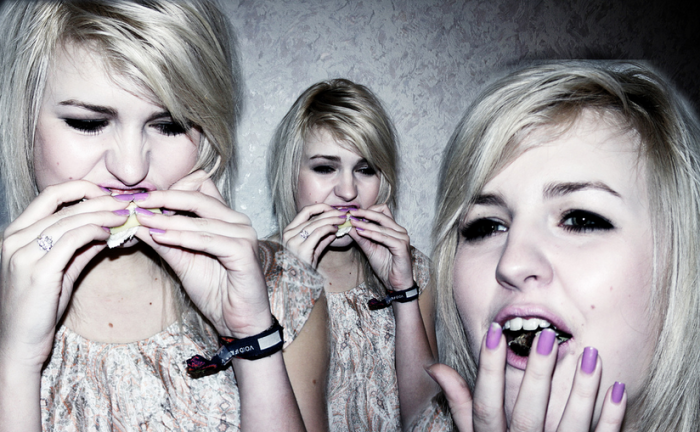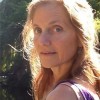
The other day I was remembering how I used to be 30 years ago when I got upset.
If I felt afraid, angry, hurt or sad—soon after, or a few hours later, I’d eat something.
Back then, I didn’t have any way of considering that I might be filling my entire psyche, mind, spirit and body with frightening images, terrified beliefs, or disturbing thoughts, all coming out as big, fearful feelings.
I might feel terrible because I perceived danger, or something bad had happened.
I’d get overwhelmed very fast.
Like those flashes on a screen that cause subliminal desire for popcorn—the mind takes in a photo so fast that our full consciousness doesn’t register it. We don’t “know” we were just shown a photo of popcorn.
That’s how my relationship with food felt—like some weird, subconscious, uncontrollable craving, or trance-like state would come over me.
I would just start eating.
When I entered therapy to find help in understanding my behavior, desperate to heal it, I discovered that most of my life I was not sure how I was going to feel from one moment to the next.
I hated that!
I wanted to feel good, safe, loved and comfortable—all the time.
If I felt unloved, threatened, and uncomfortable—that meant danger.
To change my feelings, eating was my number one go-to activity. If I was angry, I would eat with anger, shoving in food and hardly tasting it. If I was sad, I would eat very comforting foods more slowly, but I’d eat until I was stuffed. If I was terrified, I would eat quickly, gulping it down, hiding behind a closed curtain in my apartment.
Drinking often worked, too, although I would drink alcohol with other people, not so much alone—and it seemed to make me less nervous around humans.
Smoking had a way of changing the channel as well. Kind of a slow, deep breath, stepping outside somewhere: a way to pause, wait, stop.
But eating. Wow. That was rough! (No kidding, a decade of bingeing, vomiting and hating myself. That was definitely rough).
An awesome therapist I had suggested keeping a binge journal. Writing down my feelings when I ate cray-cray.
At first, I hated the idea and wouldn’t even do it—then, I tried reluctantly. I would think “I hate that this is on paper. It’s so embarrassing, so awful.”
But then, as I read my own writing, I discovered that when I over-ate, or had a huge craving to binge, or started graze eating or dreaming of food when I wasn’t hungry—
—I was always afraid, angry, sad, lonely and thinking in pretty extreme ways.
When I got more involved in studying addiction in graduate school, and when I got close to people in 12-step programs of every kind, I felt a kinship.
I started to realize that I had a very deep and abiding fear of darkness. A dark, gripping, haunting dread of emptiness, death, destruction, of being alone.
But it turned out, other people felt the same way.
“How do I react when I think the thought? I see the images, then I experience the emotions—and if I’m an addict, I’ll use. I mean, after all, life isn’t worth living anyway. I’m so depressed and no one can help me—this helps though. So I grab my drug of choice, my drink of choice, my partner of choice, my gaming. We all know how we react when we’re depressed….Anything to change the emotions.”
~ Byron Katie
What was one of the most stressful, painful thoughts that had to be in place to even want to binge eat?
“The world is a dangerous place.”
That’s a killer thought.
It puts us on alert, makes us sad, makes us feel lonely (because other people are a part of the dangerous world). It makes us build our defenses, and work hard at being careful.
But is the notion that the world is a dangerous place actually accurate?
Well, duh. The only way out is death. Everyone dies. Everything is temporary. Love is temporary, connection is unstable, people leave, people attack, there’s not enough for everyone, people suffer here.
Okay, before we see images in our mind of death, war, bombs, starvation, disease and terror, see if it’s absolutely 100 percent true that the world is a dangerous place. Look carefully.
We might still say yes. Accidents can happen here, right? Although, lots of fun, miraculous, spectacular stuff goes on as well—life, love, change, evolution, invention, joy.
But. Well. I’m still not sure. I see lots of dangerous stuff in my head.
But I notice that when I believe the world is a dangerous place, I’m not having much fun.
I’m very careful, cautious, quiet. Sometimes I grab moments of giddiness and connection with other special people—lovers, family, friends—and I act like there’s no tomorrow, so I do whatever I want today, pretending I don’t care.
Now, if I’m freaking out within, if I can I realize that I am believing a thought, taking it on, holding it as real—I can stop my process.
I imagine what it would be like to not think that thought in the same “dangerous” situation.
What happens without the thought that the world is a dangerous place? Like if all that bad stuff isn’t dangerous?
Hmmm.
“The Unknown is more vast, more open, more peaceful, and more freeing than you ever imagined it would be. If you don’t experience it that way, it means you’re not resting there; you’re still trying to know. That will cause you to suffer because you’re choosing security over Freedom. When you rest deeply in the Unknown without trying to escape, your experience becomes very vast.”
~ Adyashanti
What if it’s my mind that is a dangerous place and not the world?
Well, that explains why I am having a horrible time in my apartment, eating, when the person next door is having a wonderful time in theirs.
And this turnaround does not mean I am a terrible person, I’ve just given my mind a terrible project—believing the world is a dangerous place and reacting when I see the proof that this is true.
As I look at my fear and stay with my thinking, the part that’s causing all the pain, I spend time considering that the world is a safe place. How would I know that “All This” isn’t ingenious?
What if that darkness is my friend? Even if I’m not so sure yet. I just have the possibility that it is my friend. It feels exciting. Thrilling. Joyful.
With the thought that darkness is safe, or at least not dangerous, what do we notice about our urge to eat?
All I’ve needed to do now, apparently, is to notice that I’m upset and something within pauses. There is no wild wave of urgency to eat, change channels, get outta this place.
What happened? How did I stop obsessing about food, overeating, under eating? I stopped believing everything I was thinking. I didn’t even try not to believe it, it’s just that I couldn’t see the world as 100 percent dangerous anymore. Too much evidence to the contrary.
Scary, terrifying thoughts used to always lead to scary, terrifying eating. But when I couldn’t hold all those as absolutely real anymore—friendly, loving thoughts lead to friendly, loving eating.
What do you notice?
Love elephant and want to go steady?
Sign up for our (curated) daily and weekly newsletters!
Editorial Assistant: Bronwyn Petry/Editor: Catherine Monkman
Photos: Peter Goehring, daniellehelm, Flickr Creative Commons










Read 0 comments and reply